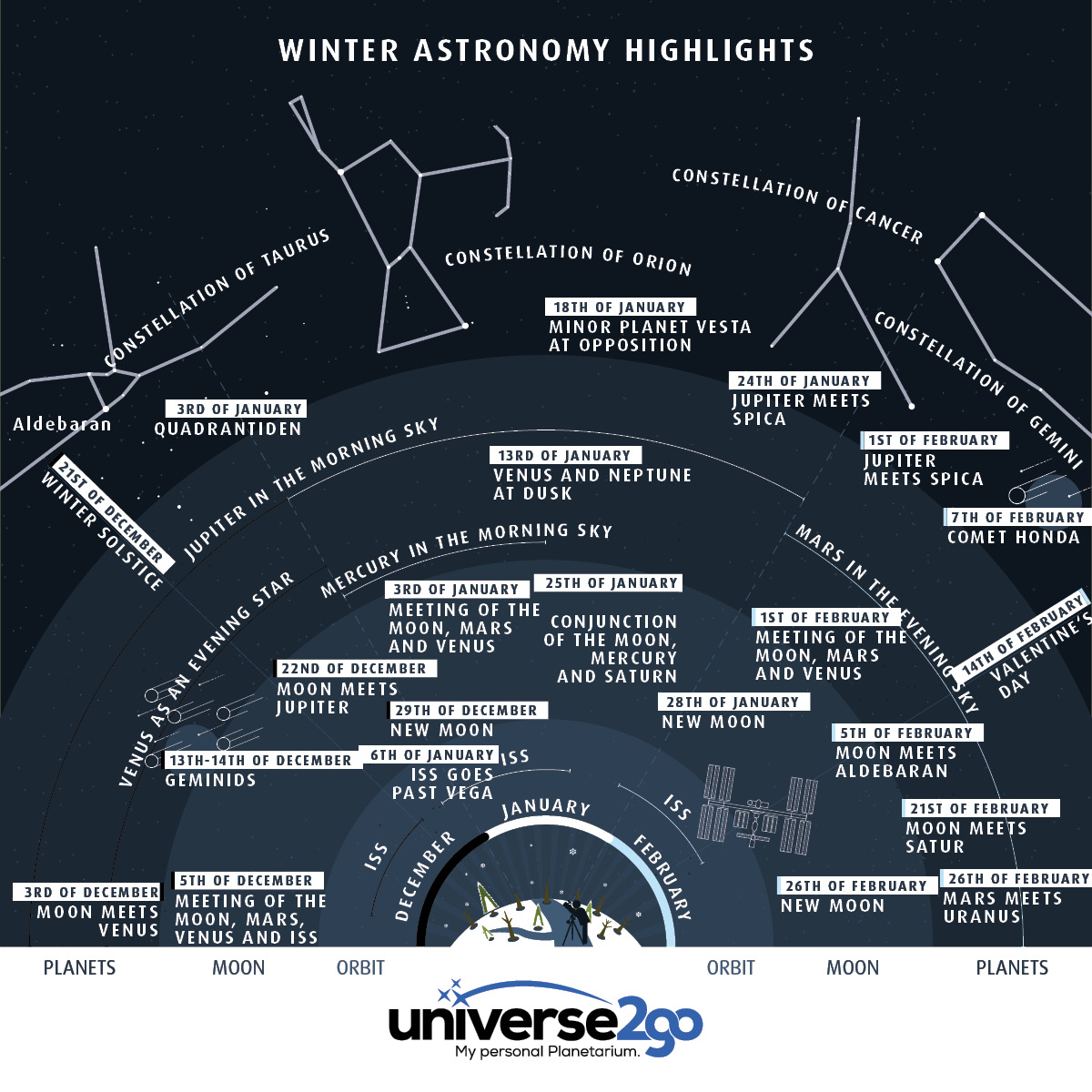Infographic: Highlights in the Winter Sky from December to February
The cold has set upon much of the northern hemisphere, but the warmth in our homes, with chimney smoke above, is comforting. Outside in the cold, starry and clear winter nights bring us some of the most wonderful stars. Who can really be unimpressed by Orion? So, what kind of interesting things can you see this winter? The new infographic “Winter Astronomy Highlights” can show you everything you need to know at a glance, what is going on from December to February.
13th – 14th December: Geminids
If you happen across a clear sky tonight, have a look to the south. The peak of Geminids meteor shower, originating from the constellation Gemini – or more precisely, from an area two degrees above the star Pollux, will take place between 9 PM and the morning hours. You can expect around 120 meteors per hour, making the Geminids one of the more active meteor showers. The Moon will abound tonight, however. Despite it drowning out some of the fainter meteors, the event should be something to behold!
21st December: Winter Solstice
Every year on the 21st or 22nd of December, we get to experience the shortest day and the longest night of the year. This year, on the 21st, Winter officially begins and the Sun will set quite early in the northern hemisphere based on your latitude. With the night lasting approximately 12 hours, such an event could be an astronomer’s dream and give anyone the chance to stare up into the heavens for extended periods of time.
22nd December: A Lunar Meeting with Jupiter
In the morning hours, a crescent Moon lit at 30% will encounter the gas giant Jupiter.Around 2:30 AM both celestial bodies will be found just above the eastern horizon, appearing about 4 degrees away from one another.
3rd January: Quadrantids
The next meteor shower, the quadrantids, are already coming in our direction. The meteor show originates from the constellation Bootes and you can expect around 120 per hour in the night sky. During the morning hours of the 2nd and 3rd, you will have the best chance to have an enjoyable night!
3rd January: Conjunction of the Moon, Mars and Venus
In the evening dusk, the Moon, Mars and Venus will provide an splendid sight. Around the late afternoon, have a look into the southwest, where you will see the three appear in a string of lights, woven into the constellation Aquarius. Of interest are the various phases of the Moon and Venus, as the second planet will be illuminated at 55%, something easily discernable with a telescope.
6th January: ISS Rolls Past Vega
Seeing a fast moving bright object in the night sky is oft surprising, yet fascinating. What you may be seeing is the ISS and is a not-so-rare occurance. However, on the 6th of January the ISS will roll closely past the star Vega, making it an interesting experience for observers and astrophotographers alike!
13th January: Venus and Neptune at Dusk
Venus along with the distant and exotic planet, Neptune, will be found in the constellation Aquarius. In the evening of the 13th of January, Venus will roll past Neptune just to the north. At a distance of approximately one Moon’s diameter, the sight is one to behold if you have binoculars or a telescope with even a small magnification.
18th January: Minor Planet Vesta at Opposition
Stars, Planets and Nebulae. There is of course more to the universe, such as minor planets. Vesta, the 2nd largest asteroid in the solar system, will be found at opposition, meaning that it will be visible throughout the night after reaching its brightest appearance. With 6,2 mag, you will be able to see it with the naked eye in an extremely dark night sky. Binos and telescopes will be a great accessory to have as well! Given that a minor planet is difficult to differentiate from a star, you will need a star chart in order to find Vesta.
24th January: Jupiter’s Encounter with Spica
From the 24th of January, both Jupiter and Spica will be in close proximity and found within the constellation Virgo.
25th January: Conjunction of the Moon, Mercury and Saturn
Around 7 Am in the Morning, the Moon and Mercury will appear near the eastern horizon – a special sight indeed! As the Moon will only be illuminated at 3%, Saturn can be found close by, just above the constellation Ophiucus.
1st February: Moon, Mars and Venus
Above the southwestern horizon, Mars and Venus will be visible. Tonight, the Moon will make good company, creating a string in the night sky between Pisces and Cetus. The Moon will be a waxing sickle, with Uranus far above it, glittering in the darkness. With so many interesting objects to see, the evening can only be galactically good.
5th February: Moon Encounters Aldebaran
The giant red Aldebaran will rule the constellation Taurus, and this evening encounter a waxing Moon. The two will be separated at about 15 degrees.
7th February: Comet 45P/Honda-Mrkos-Pajdusakova
Once again, we can witness a bright comet. 45P/Honda-Mrkos-Pajdusakova (short: Honda) will wander through the constellations Aquila, Ophiuchus, Hercules, the Northern Crown and Boötes. Around 3 AM, the comet will appear with a 7.8 mag, making it a fantastic object for binoculars. Throughout February, it will continue along its path, while the brightness will sink significantly.
21st February: Mond Encounters Saturn
Just before Sun-up, the waning Moon sickle and Saturn will make a nice pair, making it worth a gander for all those early birds.
26th February: Mars Encounters Uranus
Shortly before month’s end, Mars and Uranus will shake hands. Both will be visible in the western sky near Pisces. Uranus will be only a single degree northwest of Mars. With a new Moon, the night is quite promising for intense observers.
With the following Code, you can imbed the above infographic in your blog:
Clear skies!







